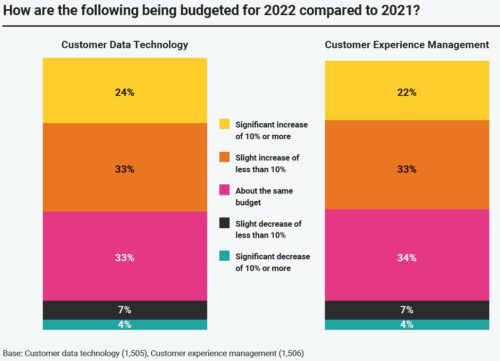Insights from Adobe’s 2022 Digital Trends Report
by Julia Pott (exclusively for EuroShop.mag)
The years of the COVID-19 pandemic have presented many challenges to businesses and there seems to be no end in sight: while the acceleration in digital transformation unleashes endless possibilities, it also highlights the importance of adaptability. The annual Adobe study explores the biggest digital trends and their impact on businesses in the year 2022.
In partnership with Econsultancy, Adobe conducted a survey of nearly 9,500 participants, which included marketers, corporate professionals, consultants, and employees of solution providers. According to Adobe, the study aims to identify important developments that are shaping marketing, advertising, and commerce.
Digital-first and customer-centric strategies to meet new demands and expectations

Question asked, “How are the following items estimated to increase in 2022 compared to 2021?” Responses for customer data technology versus customer experience management technology, ranging from a significant increase of 10 percent or more (top) to a significant decrease of 10 percent or more (bottom).
The report finds that the COVID-19 pandemic has prompted consumers to leapfrog several years of development as it pertains to their digital expectations and behavior. Next to shifting consumer expectations, the changes driven by the pandemic and the fight against it have forced many companies to fast-track digital change to stay competitive.
Patrick McLean, SVP & Chief Marketing Officer at Walgreens, is quoted as saying that the key activity of any entrepreneur increasingly centers on the customer experience. There is a surge in the use of digital channels by consumers in all areas of life, from shopping and work to leisure and social contacts. “Eighty-seven percent of our surveyed senior executive respondents agreed that the events of 2020/21 have rewired customers to be digital-first.”
Omnichannel services are based on data management
Claire Hepworth, Head of Customer Engagement at Ford, says the company had already focused on the importance of omnichannel strategies before the pandemic, but “[w]hen the pandemic hit, it became a central part of our plan, integral to how we kept selling.”
The study points out that consumers are now less accepting of any barriers across online and offline channels. They expect the same high-quality (digital) consumer experience from all companies along the entire customer journey – and across different economic sectors.
“Megatrends are reshaping the dynamics of our industry. Content, community, and offerings have to be personalized. The consumer has to have the same experience along the various touchpoints with you, whether online or offline.” Michael Nilles, Chief Digital and Transformational Officer, Henkel
This necessitates a comprehensive data network and responsible data management that inspires consumer trust. Data protection and transparent data management is becoming increasingly important for both consumers and many organizations. “That means engaging in ways that feel contextual and intuitive rather than invasive or surveilling,” say the authors of the text.
There are always new data protection challenges to consider, including new guidelines, recommendations, and best practices. “The problem is, everything that we have done over the last 10-15 years has been based on cookies. It’s the technology that everybody knows. […] That’s what we are good at. And then suddenly, we have been asked, hey, how do we do this without cookies,” explains Ajit Sivadasan, Vice President at Lenovo.
To meet these high standards, companies must also assess their internal structures and focus on great integration between technology systems, workflows, digital skills, and qualified employees. According to the study, Walmart is a great example of this: The retail corporation overhauled its internal communications structure early on and eliminated hurdles for employees, freeing them to improve the customer experience. The authors of the study detected increases in investments on data technology to improve customer data analysis and optimize the customer experience.
Success factors: Agility, digital competence, and adaptability skills

© Envato/friends_stock
The study makes a key recommendation to companies who plan to stay successful and survive against fierce competition: become more agile! The study cites Marc van der Heijden, Chief Technology Officer at the Alshaya Group, as an example: “We learned that when we work as a team, without falling into the trap of overthinking things, we can make good decisions. Even when we made mistakes, we were able to come together remotely, learn, and adapt on the fly, knowing that we would get there in the end.” The strategy helped the company to launch 30 e-commerce sites and two mobile apps in 12 months.
The authors recommend heterogeneous marketing teams who are diverse in terms of their abilities and skills as the foundation of agile marketing. This provides the right conditions to foster creative ideas and novel solutions.
Building on this, good work organization and valuable data are essential. Avery Worthing-Jones, Senior Vice President of Product Management at Gap Inc., admits it’s a challenge to extract actionable insights from this data. “You know, we used to talk about how data is the new oil, right? Well, I sort of evolved that thought process to getting oil out of shale; it’s harder to get value than anyone thought originally.”
The authors emphasize that while it’s important to gain insights, companies must also do so quickly. This is where artificial intelligence comes in – though in reality it remains underutilized. “This is a missed opportunity. Accessing AI-driven insights does not rely on scarce skillsets or cumbersome technology. Sales forecasting and audience micro-targeting solutions are available out of the box – and can be readily used by non-technical practitioners, helping lagging businesses pick up the pace, meet customer needs, leapfrog competitors, and overcome skill shortages.”
In summary, the authors of the study see the following triad as the model that forms the basis for success:
- Improve the focus on your (potential) customers
- Improve both your external and internal data flow and data analytics
- Build strong diverse teams with powerful skills to drive your business forward



















